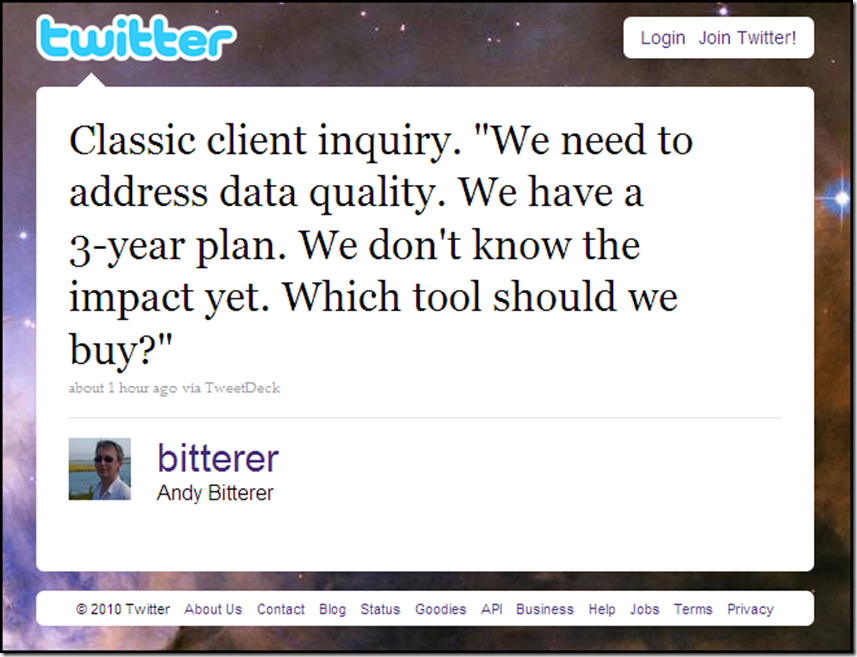Why No One Cares about Poor Data Quality
/OCDQ Radio is an audio podcast about data quality and its related disciplines, produced and hosted by Jim Harris.
Why does no one care about poor data quality? Because you’re probably measuring data quality without connecting it to your organization’s business processes, applications, or other business uses for enterprise data.
During this episode, I discuss how this is accomplished through the implementation of a data governance policy as an executable process comprised of a combination of business rules and data rules that create and track meaningful data quality metrics framed within a relative business context and associated with a data quality threshold (i.e., tolerance for poor data quality). Each business use for enterprise data should be governed by its own policy. Compliance with these data governance policies aligns data quality with business insight, providing the missing link between poor data quality and poor business performance. And it is then—and only then—that anyone cares about poor data quality.
Popular OCDQ Radio Episodes
Clicking on the link will take you to the episode’s blog post:
- Demystifying Data Science — Guest Melinda Thielbar, a Ph.D. Statistician, discusses what a data scientist does and provides a straightforward explanation of key concepts such as signal-to-noise ratio, uncertainty, and correlation.
- Data Quality and Big Data — Guest Tom Redman (aka the “Data Doc”) discusses Data Quality and Big Data, including if data quality matters less in larger data sets, and if statistical outliers represent business insights or data quality issues.
- Gaining a Competitive Advantage with Data — Guest William McKnight discusses some of the practical, hands-on guidance provided by his book Information Management: Strategies for Gaining a Competitive Advantage with Data.
- Doing Data Governance — Guest John Ladley discusses his book How to Design, Deploy and Sustain Data Governance and how to understand the difference and relationship between data governance and enterprise information management.
- Demystifying Master Data Management — Guest John Owens explains the three types of data (Transaction, Domain, Master), the four master data entities (Party, Product, Location, Asset), and the Party-Role Relationship, which is where we find many of the terms commonly used to describe the Party master data entity (e.g., Customer, Supplier, Employee).
- Measuring Data Quality for Ongoing Improvement — Guest Laura Sebastian-Coleman discusses bringing together a better understanding of what is represented in data with the expectations for use in order to improve the overall quality of data.
- The Blue Box of Information Quality — Guest Daragh O Brien on why Information Quality is bigger on the inside, using stories as an analytical tool and change management technique, and why we must never forget that “people are cool.”
- Data Governance Star Wars — Special Guests Rob Karel and Gwen Thomas joined this extended, and Star Wars themed, discussion about how to balance bureaucracy and business agility during the execution of data governance programs.
- Good-Enough Data for Fast-Enough Decisions — Guest Julie Hunt discusses Data Quality and Business Intelligence, including the speed versus quality debate of near-real-time decision making, and the future of predictive analytics.
- The Johari Window of Data Quality — Guest Martin Doyle discusses helping people better understand their data and assess its business impacts, not just the negative impacts of bad data quality, but also the positive impacts of good data quality.
- The Art of Data Matching — Guest Henrik Liliendahl Sørensen discusses data matching concepts and practices, including different match techniques, candidate selection, presentation of match results, and business applications of data matching.
- Studying Data Quality — Guest Gordon Hamilton discusses the key concepts from recommended data quality books, including those which he has implemented in his career as a data quality practitioner.





